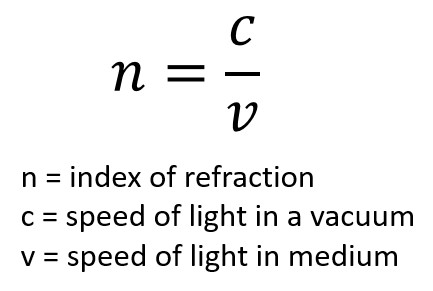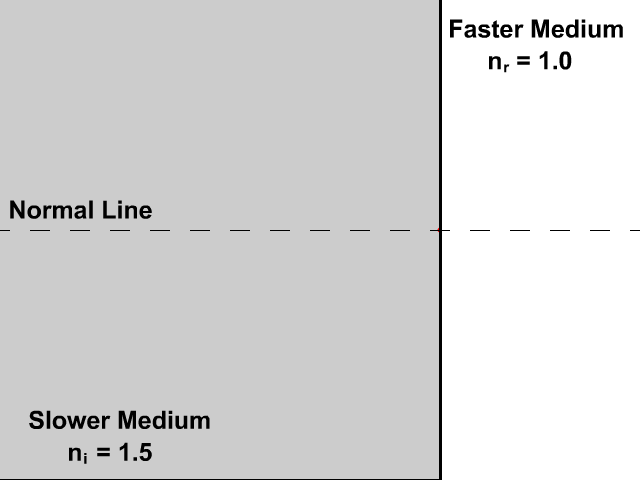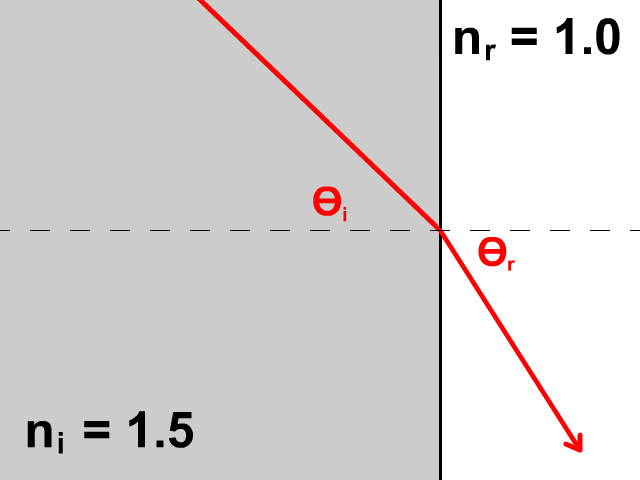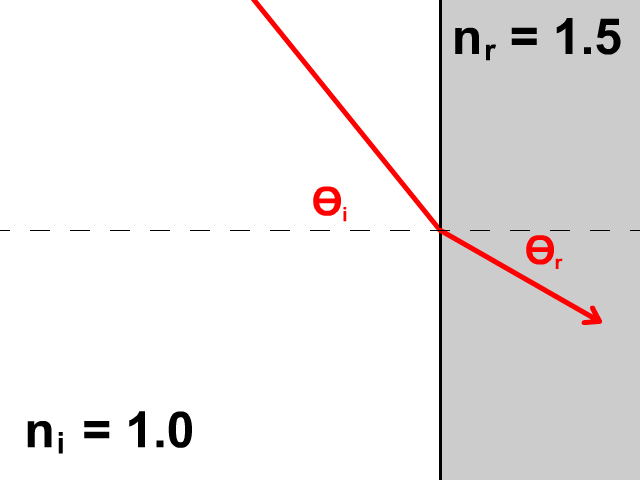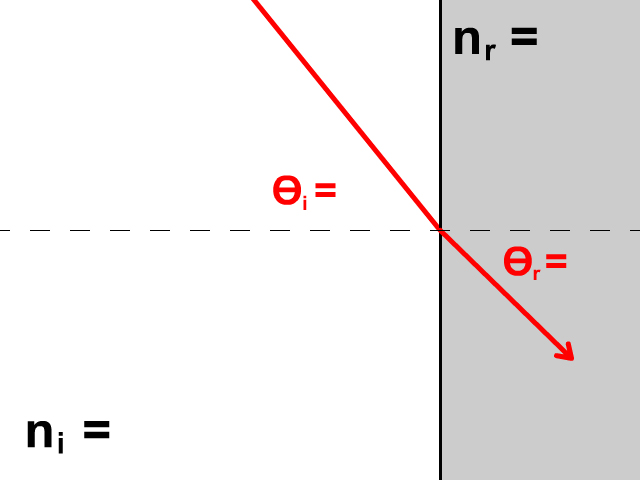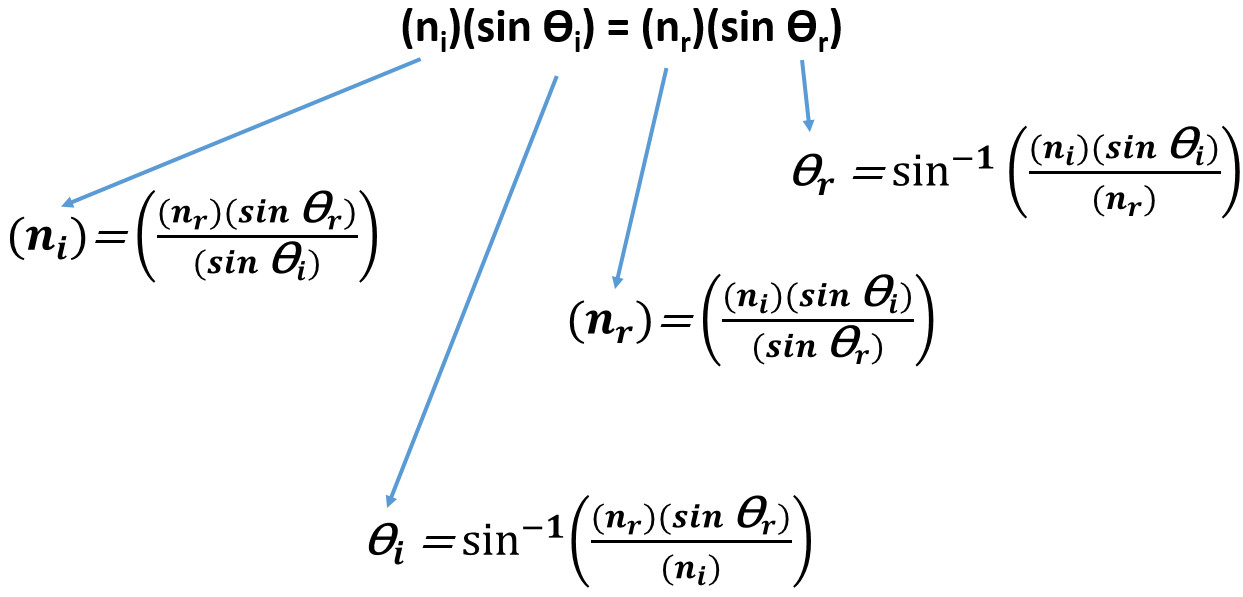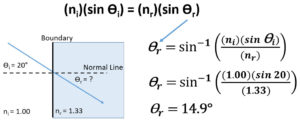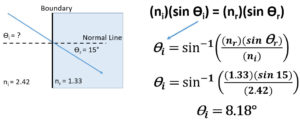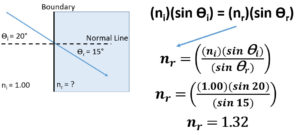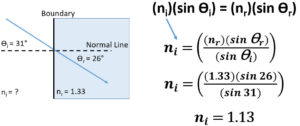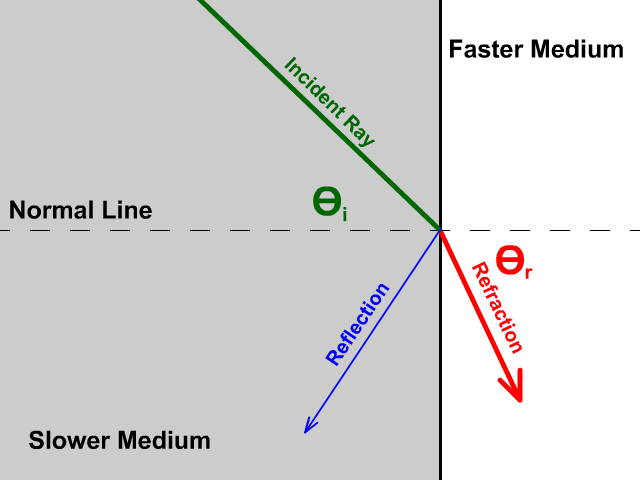Refraction of Light
Learn about the refraction of light and Snell's law. Learn how to solve for the angle that light bends when going from one medium to another.
The reason why a pencil in water appears to be bending is due to the speed of light in different medium. Light bends when approaching a boundary between to medium where the speed of light is different. Light travels faster in air and slower in water creating the phenomenon you see here.
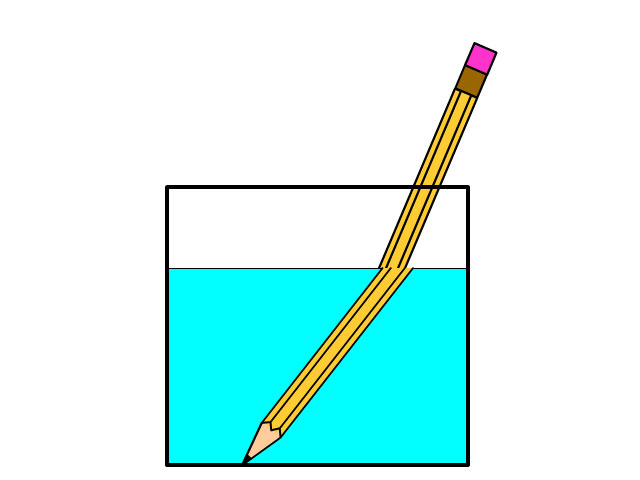
Refraction of Light Variables
| Name | Variable | Unit | Unit Abbreviation |
| Speed of light | c | meters per second | m/s |
| Velocity | v | meters per second | m/s |
| Index of Refraction | n | none | |
| Index of Refraction (Incident Side) | ni | none | |
| Index of Refraction (Refracted Side) | nr | none | |
| Angle of Incidence | Өi | degrees | ° |
| Angle of Refraction | Өr | degrees | ° |
| Critical Angle | ӨC | degrees | ° |
The Speed of Light in Various Medium
Light is an electromagnetic wave that travels fastest in the vacuum of space, slower in gas, and slowest in a solid because of density.
Light has a different speed in different translucent solids. Translucent means you can see through them. The velocity that light will travel in a certain medium can be calculated using a variable called the index of refraction (n). This will also be used later on this page to determine how much light will bend from one medium to another.
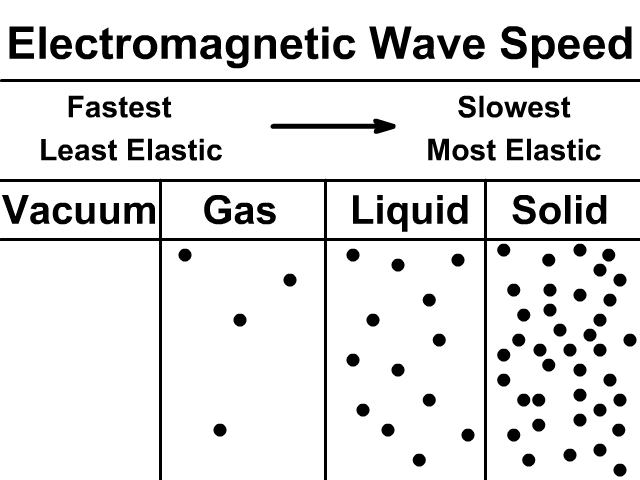
Index of Refraction (n)
The index of refraction is the ratio of speed of light in a vacuum (c) to speed of light in another medium (v).
- The index of refraction (n) is always 1 or greater
- The larger the index of refraction (n) the slower light travels in that medium
- The index of refraction (n) has as no unit
The variable c is a constant that stands for the speed of light in a vacuum. This is the universal speed limit and always 3.0 x 108 m/s with nothing faster.
The index of refraction equation is:
n = c/v
Variables in this equation are:
c = 3.0 x 108 m/s
n = index of refraction
v = velocity of light in a medium
Since c is a constant 3.0 x 108 m/s, the index of refraction equation n = c/v will always be n = (3.0 x 108)/v
The index of refraction (n) will never be less than 1 since the velocity of light in any medium (v) can not be faster than the universal speed limit (c) of 3.0 x 108 m/s. The denominator of n =c/v will never be bigger than the numerator and therefore not give an index of refraction (n) below 1.
Example Problems
1. What is the speed of light in water that has an index of refraction of 1.333?
2. What is the speed of light in diamond that has an index of refraction of 2.419?
3. What is the index of refraction for ice at 20° C where light travels at 2.29 x 108 m/s?
4. Does light travel faster in diamond with an index of refraction of 2.419 or cubic zirconia with an index of refraction of 2.20?
| Indices of Refraction for Various Substances | ||
| Solid | Index of Refraction (n) | |
| Diamond | 2.419 | |
| Cubic zirconia | 2.20 | |
| Crown Glass | 1.52 | |
| Liquid | ||
| Glycerine | 1.473 | |
| Ethyl alcohol | 1.361 | |
| Water | 1.333 | |
| Gas | ||
| Air | 1.000293 | |
| Carbon dioxide | 1.000450 | |
Slower Medium to Faster Medium
Observe that as light enters the right side of the diagram it has a smaller index of refraction (nr) which means it is traveling faster. Light bends away from the normal line on the second or refracted side when this happens.
- Slower medium to faster medium
- (ni) bigger than (nr)
- Bends away from the normal line
Faster Medium to Slower Medium
Observe that as light enters the right side of the diagram it has a larger index of refraction (nr) which means it is traveling slower. Light bends towards the normal line on the second or refracted side when this happens.
- Faster medium to slower medium
- (ni) smaller than (nr)
- Bends toward the normal line
Snell's Law
Snell's law can be used to mathematically calculate the angle of bend or index of refraction on the incident side or refracted side when light travels between two medium.
With two medium we need subscripts to specify the side light is traveling in. Use subscripts (i) for incident side and (r) for refracted side.
- Incident (i): first side where light starts
- Refracted(r): second side where light goes
Calculation Tips With Snell's Law
You will have to do a bit of algebra to solve for various components in Snell's law. Here are the rearranged equations you can check your work with.
- When using Sin and Sin-1 you will have to make sure your calculator’s mode is in degrees. With most TI graphing calculators there is a button for mode. When you hit mode, there is an option for radian or degree. Make sure it is on degrees. This may be a reason if you do everything right but your calculated answer is wrong.
- Be sure to use the correct trig function Sin or Sin-1 if you are not getting the right answer this may also be why.
- Use lots of (parenthesis), your calculator follows the order of operations and this makes sure the entire value you are calculating is in the right place
Example Problems
5. Will light bend toward or away from the normal line when going from a slow medium to a fast medium?
6. Will light bend toward or away from the normal line when going from air (n=1.00) to water (n=1.33)?
7. What is the angle of refraction when the angle of incidence is 20° when going from air (n=1.00) to water (n=1.33)?
8. What is the angle of incidence when the angle of refraction is 15° when going from diamond (n=2.42) to water (n=1.33)?
9. What is the index of refraction for an unknown substance when the angle of incidence is 20° in air (n=1.00) and angle of refraction is 15° in the unknown substance?
10. What is the index of refraction for an unknown substance when the angle of incidence is 31° in the unknown and a angle of refraction is 26° in water (n=1.33)?
Total Internal Reflection
Light bends away from the normal line when going from a slower to a faster medium. As the angle of incidence increases, so does the angle of refraction. Light no longer refracts into a faster medium after a certain angle called the critical angle. Beyond the critical angle you have total internal reflection and no refraction.
Solving for the critical angle (Өc):
Өc = sin-1((nr)/ (ni))
- Total Internal Reflection: After passing the critical angle, light no longer refracts only reflects
- Critical Angle: Angle of incidence after which light will only reflect and not refract
- You will only have a critical angle and total internal reflection when light travels from slow to fast medium where light bends away from the normal line.
Example Problem
11. What is the critical angle for light in diamond (2.42) going into to air (1.00)?
Links
- On to Other EM Wave Phenomenon
- Back to the Main Electromagnetic Waves Page
- Back to the Stickman Physics Home Page
- Equation Sheet

